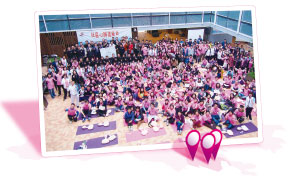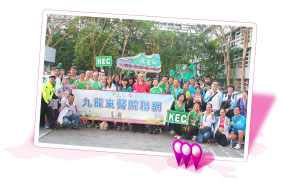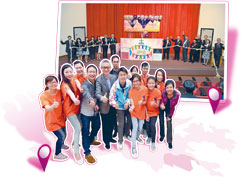Kowloon East Cluster (KEC)
Number of general outpatient clinics8
Throughput
Number of beds 2,491
Patient discharges* 176,556
A&E attendances 320,071
Specialist outpatient attendances (clinical) 795,801
General outpatient attendances 944,950
Full-time equivalent staff 7,281
Manpower constraint remained a key challenge for KEC. To allay staff shortage, KEC recruited additional nurses to replenish manpower shortfall in hospital wards. More allied health professionals were added to cope with increased workload and strengthen support for patients requiring multi-disciplinary care and rehabilitation. Patient care assistants were injected to share out simple clinical tasks and relieve clerical workload of allied health professionals.
 |
To address growing service demand and pressure areas, the Cluster added two Intensive Care Unit beds and two Coronary Care Unit beds. Service capacity was broadened by implementing 24-hour thrombolytic service for acute ischaemic stroke patients, increasing treatment quota for renal replacement therapy for patients with end-stage renal disease and specialist outpatient clinic sessions as well as introducing cardiac catheterisation
|
laboratory service. This year, KEC continued to increase the general outpatient clinic episodic quota by 11,000 attendances to meet growing service demand. To alleviate the access block at A&E departments, additional support sessions were rendered for handling patients of Triage IV and V categories. The Cluster also enhanced mental health services by providing recovery oriented treatment programmes for patients in the psychiatric wards. The long waiting time at specialist outpatient clinic pharmacies was alleviated by recruiting additional dispensers. Case management service was available to patients with complicated breast and colorectal cancer. The Cluster also provided prosthetic service to support rehabilitation and continuity of care. |
| On service quality and safety side, a barcode-based tracking and archiving system was implemented in anatomical pathology laboratories to ensure correct identification of anatomical pathology specimens. KEC stepped up the adoption of minimal invasive surgery technique in hysterectomy surgeries for suitable gynaecology patients. In addition, the Cluster phased out the re-use of selected |
 |
| types of class II moderate and moderate-high risk single use device according to clinical risk prioritisation. An implementation team was set up to support the launching of Inpatient Medication Order Entry system. Besides, matrix-assisted laser desorption / ionisation time-of-flight (MALDI-TOF) mass spectrometry was installed to speed up microbiological identification for timely diagnosis and treatment.
In strengthening partnership with patients and community, case managers were recruited to deliver integrated care for children with special care needs, such as those with mental retardation or physical disabilities.
|
 |
The Kwun Tong Community Health Centre commenced operation in March 2015. The centre provided an integrated range of services including general outpatient clinic service and various chronic disease management programmes.
KEC is committed to ensuring smooth progress of major capital projects of UCH and HHH expansion through close |
monitoring. The UCH planning team was strengthened to facilitate service transition during the decanting period of the UCH expansion project. Site renovation and preparatory works were carried out for setting up an emergency medicine ward in TKOH.


